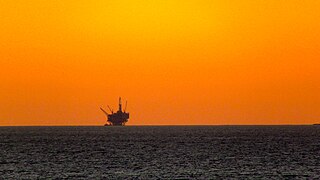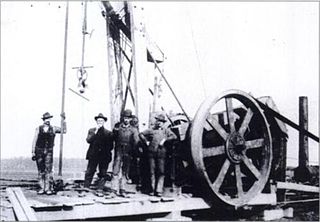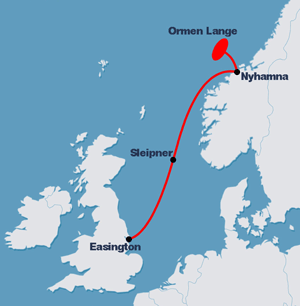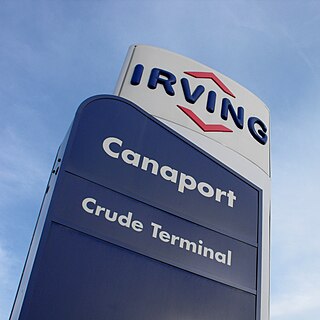
Enron Corporation was an American energy, commodities, and services company based in Houston, Texas. It was founded in 1985 as a merger between Houston Natural Gas and InterNorth, both relatively small regional companies. Before its bankruptcy on December 3, 2001, Enron employed approximately 29,000 staff and was a major electricity, natural gas, communications and pulp and paper company, with claimed revenues of nearly $101 billion during 2000. Fortune named Enron "America's Most Innovative Company" for six consecutive years.

Pipeline transport is the long-distance transportation of a liquid or gas through a system of pipes—a pipeline—typically to a market area for consumption. The latest data from 2014 gives a total of slightly less than 2,175,000 miles (3,500,000 km) of pipeline in 120 countries of the world. The United States had 65%, Russia had 8%, and Canada had 3%, thus 75% of all pipeline were in these three countries.

An oil platform, offshore platform, or offshore drilling rig is a large structure with facilities for well drilling to explore, extract, store, and process petroleum and natural gas which lies in rock formations beneath the seabed. Many oil platforms will also contain facilities to accommodate their workforce.

Offshore construction is the installation of structures and facilities in a marine environment, usually for the production and transmission of electricity, oil, gas and other resources. It is also called maritime engineering.

An oil well is a boring in the Earth that is designed to bring petroleum oil hydrocarbons to the surface. Usually some natural gas is released along with the oil. A well that is designed to produce only gas may be termed a gas well.

A diving support vessel is a ship that is used as a floating base for professional diving projects.

Snorre is an oil and gas field in the Tampen area in the southern part of the Norwegian Sea. The sea depth in the area is 300 to 350 metres. Snorre has been operational since August 1992. It was the first field developed by Saga Petroleum.

National Oilwell Varco (NOV) is an American multinational corporation based in Houston, Texas. It is a leading worldwide provider of equipment and components used in oil and gas drilling and production operations, oilfield services, and supply chain integration services to the upstream oil and gas industry. The company conducts operations in more than 600 locations across six continents, operating through three reporting segments: Rig Technologies, Wellbore Technologies, and Completion & Production Solutions.

Mittelplate is Germany's largest oil field, 7 km (4.3 mi) from the shore, in the environmentally important Schleswig-Holstein Wadden Sea National Parks tidal flats. The development of the field was done by a consortium of RWE Dea AG and Wintershall AG. By the 20th anniversary of the start of production, 20 million tonnes of crude had been produced from the field. Mittelplate field holds nearly 65% of Germany's crude oil reserves.

Valhall is an oil field in the Norwegian sector of the North Sea. Discovered in 1975, production began in 1982 and is expected to continue until 2050. Valhall is located in 70 metres of water. It produces from chalk in the Tor and Hod Formations of Late Cretaceous age. The reservoir depth is approximately 2 400 metres.

The Central Area Transmission System is a natural gas transportation and processing system that transports gas through 404 kilometres of pipeline from the Central North Sea to a reception and processing terminal at Teesside in the North East of England.

The Indiana gas boom was a period of active drilling and production of natural gas in the Trenton Gas Field, in the US state of Indiana and the adjacent northwest part of Ohio. The boom began in the early 1880s and lasted into the early 20th century.

A pipelaying ship is a maritime vessel used in the construction of subsea infrastructure. It serves to connect oil production platforms with refineries on shore. To accomplish this goal a typical pipelaying vessel carries a heavy lift crane, used to install pumps and valves, and equipment to lay pipe between subsea structures.
A berth is a designated location in a port or harbour used for mooring vessels when they are not at sea. Berths provide a vertical front which allows safe and secure mooring that can then facilitate the unloading or loading of cargo or people from vessels.
Pembina Pipeline is a Canadian corporation that operates transportation and storage infrastructure delivering oil and natural gas to and from parts of Western Canada ; there is also a natural gas processing business that takes place at the Cutbank Complex. Western Canada is the source of all the product transported by its systems. Some of the pipelines and facilities have short term contracts with oil producers while others are long term. For 37 years until 1997 when it went public and established itself as a trust, Pembina was a regular privately owned business. On October 1, 2010 it converted to a corporation from a trust, changing its official name from Pembina Pipeline Income Fund to Pembina Pipeline Corporation. As of 2016 the company had more than 1260 employees up from 427 in 2010. The company's total assets nearly doubled in 2017.

The Kimmeridge Oil Field is to the northwest of Kimmeridge Bay, on the south coast of the Isle of Purbeck, in Dorset, England.

A submarine pipeline is a pipeline that is laid on the seabed or below it inside a trench. In some cases, the pipeline is mostly on-land but in places it crosses water expanses, such as small seas, straits and rivers. Submarine pipelines are used primarily to carry oil or gas, but transportation of water is also important. A distinction is sometimes made between a flowline and a pipeline. The former is an intrafield pipeline, in the sense that it is used to connect subsea wellheads, manifolds and the platform within a particular development field. The latter, sometimes referred to as an export pipeline, is used to bring the resource to shore. Sizeable pipeline construction projects need to take into account a large number of factors, such as the offshore ecology, geohazards and environmental loading – they are often undertaken by multidisciplinary, international teams.

Canaport is a Canadian marine crude oil receiving terminal located on the north shore of the Bay of Fundy at Mispec Point, approximately 9 km (5.6 mi) southeast of the city of Saint John, New Brunswick.

Kasenyi is a village in Ngedwo sub county, Buliisa District, in the Western Region of Uganda. It is the location of a "central processing facility" (CPF) of Uganda's oil fields in the Albertine Graben.
















